I know the excitement of being new to the world of horses and the eagerness to bond with these beautiful animals.
However, it’s crucial to understand that approaching a horse might seem simple, but doing it correctly is essential for your safety and theirs. Let’s go over how not to approach a horse.
Just like the time I had a memorable experience on my birthday when I was about 9 or 10 years old.
My best friend had convinced the owners of a horse camp to let me join for just one day as a birthday present.
I was going to ride Dijon, a dark bay grumpy gelding, but as I approached him, I misread his body language, which led to a painful encounter.
From that day, I learned the importance of being cautious when approaching horses, reading their body language, and considering their quirks and temperament before interacting with them.
Approaching horses safely is vital for both the horse and handler.
Approach slowly and confidently from the front, observing their body language, and avoid startling them from behind.
Respect their personal space, dress appropriately, and be assertive yet gentle.
This article will help you avoid common mistakes when approaching horses, fostering a strong, safe connection with them.
Let’s journey together to become better horse handlers!
| Key Points to be Covered in This Article: |
| Importance of approaching horses correctly for safety |
| Paying attention to the horse’s body language |
| Appropriate approach angles and techniques |
| Avoiding common mistakes when approaching horses |
| Confidence and assertiveness in handling horses |
Table Of Contents
- Mistake #1: Approaching too quickly or suddenly
- Mistake #2: Not paying attention to the horse’s body language
- Mistake #3: Making loud noises or sudden movements
- Mistake #4: Not approaching from the side or shoulder
- Mistake #5: Approaching with food or treats
- Mistake #6: Not respecting the horse’s personal space
- Mistake #7: Approaching a horse from behind
- Mistake #8: Not being confident or assertive enough
- Mistake #9: Not having proper training or experience with horses
- Summing up Mistakes When Approaching Horses
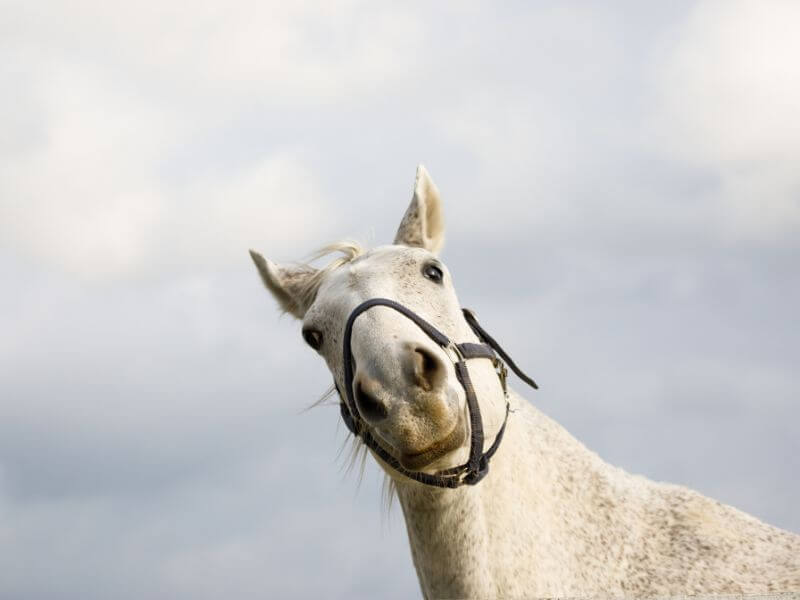
Mistake #1: Approaching too quickly or suddenly
Do you remember the first time you met someone important to you?
You probably didn’t rush up to them like a tornado, right?
The same applies to horses.
They can be quite sensitive to sudden movements or changes in their environment.
Why approaching too quickly or suddenly can be dangerous
Horses are prey animals, which means they’re always on the lookout for potential threats.
Approaching a horse too quickly or suddenly can startle them and cause them to react unpredictably, leading to injury for both the horse and the handler.
Signs that a horse is uncomfortable with your approach
When a horse feels threatened, you might notice some of the following signs:
| Signs of Discomfort | Description |
| Pinned ears | The horse’s ears are flattened against their head, signaling fear or aggression. |
| Raised tail | The tail is lifted, indicating tension or discomfort. |
| Wide eyes | Whites of the eyes are showing, revealing anxiety or fear. |
| Tense body posture | The horse’s body is stiff, indicating unease or potential for sudden movement. |
If you notice any of these signs, stop and give the horse some space.
Advice on how to approach a horse at the proper speed
Following these advice can help you approach a horse comfortably and at the appropriate pace:
- Approach the horse quietly and carefully while keeping your hands by your sides.
- To let the horse know you are there, speak quietly.
- To avoid surprising the horse, approach from the front and angle yourself towards their shoulder.
- If the horse feels uneasy, halt and give it a moment to settle down before moving on.
These recommendations can help you approach horses safely and politely, reducing the possibility of unexpected reactions and fostering a positive environment for both you and the horse.
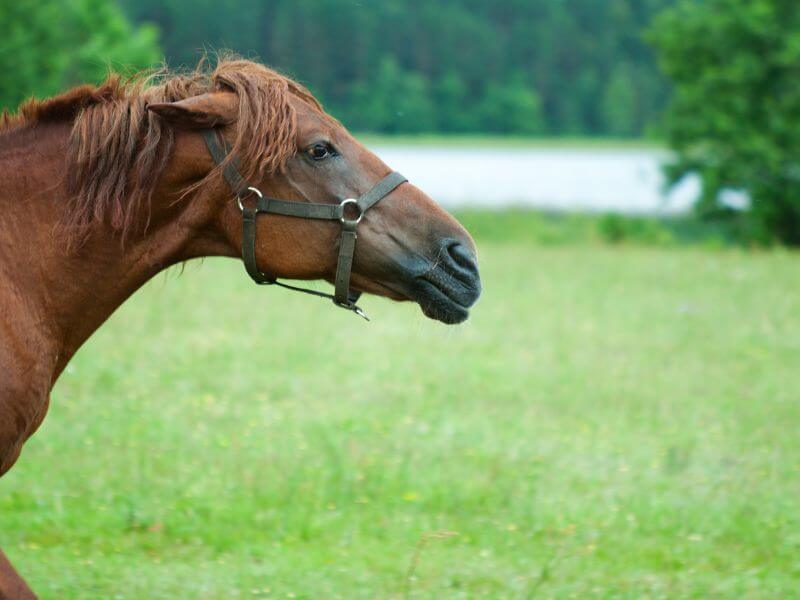
Mistake #2: Not paying attention to the horse’s body language
Just like people, horses communicate a lot through their body language.
It’s essential to pay attention to these cues to understand how the horse is feeling and respond accordingly.
My best friend Julia and my cousin Cheryl were the ones who first taught me the importance of paying attention to a horse’s body language.
Over time, I learned to look at more than just the horse’s ears and observe other signs of discomfort or aggression.
Understanding a horse’s body language
Horses express their emotions and intents through many body parts, including their ears, eyes, tail, and overall stance.
Understanding a horse’s body language is critical for safety and respect since horses may display emotions like happiness, calm, worry, fear, and aggression.
Learning to interpret these signals can also help you create a stronger bond with your horse.
How to recognize when a horse is feeling threatened or uncomfortable
Some common signs that a horse is feeling threatened or uncomfortable include:
| Signs of Discomfort | Description |
| Ears are moving around alot or pinned | The horse’s ears are moving around a lot signaling alertness or flattened against their head, signaling fear or aggression. |
| Wide eyes | Whites of the eyes are showing, revealing anxiety or fear. |
| Stiff raised tail | The tail is lifted and stiff, indicating tension or discomfort. |
| Tense body posture | The horse’s body is stiff, indicating unease or potential for sudden movement. |
| Moving away | The horse tries to distance itself from the handler, showing discomfort or fear. |
Tips for reading a horse’s body language and adjusting your approach accordingly
- Observe the horse from a distance before approaching.
- Keep an eye on the horse’s ears, eyes, and tail for signs of discomfort.
- Use your voice to make yourself known and make sure the horse sees you.
- Approach the horse slowly and confidently, allowing the horse to smell your hand.
- Touch the horse gently on the shoulder or neck, avoiding sudden movements or loud noises.
- Be aware of the horse’s blind spots in front and behind them and avoid approaching from those angles.
- If the horse seems uneasy, give it some space and try approaching again later.
You may create a safer and more respectful atmosphere for both you and the horse by paying attention to the horse’s body language and altering your approach accordingly.
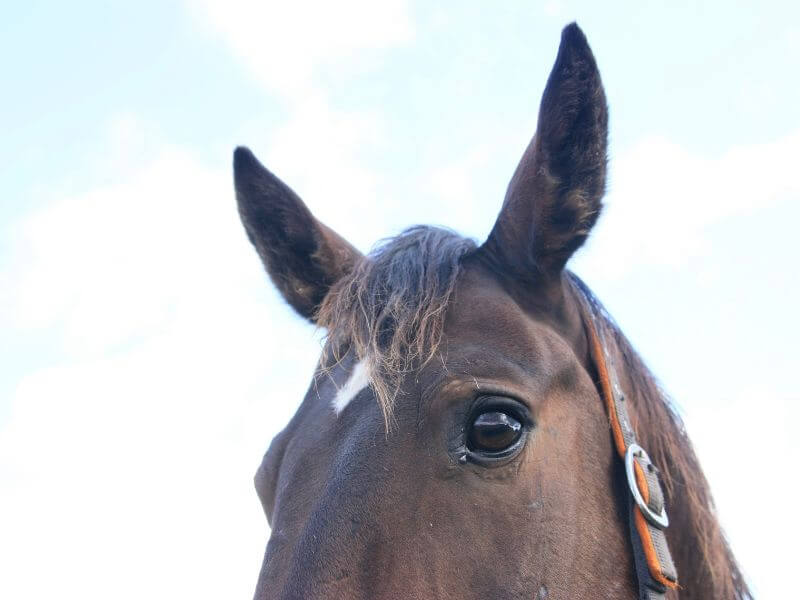
Mistake #3: Making loud noises or sudden movements
Horses have excellent hearing and are easily startled by loud noises or sudden movements.
It’s essential to be mindful of your actions around horses to avoid causing unnecessary stress or fear.
Why loud noises and sudden movements can startle a horse
Horses are naturally alert and sensitive to their surroundings as flight animals.
Loud noises or sudden movements can trigger their flight response, causing them to react unpredictably, leading to injury for both the horse and the handler.
Examples of loud noises and sudden movements that can frighten a horse
| Noise/Movement | Description |
| Slamming doors or gates | Sudden, loud noises from doors or gates can startle a horse. |
| Yelling or shouting | Loud human voices can be perceived as threats. |
| Running or jumping near the horse | Rapid movements can trigger a horse’s flight response. |
| Dropping or throwing objects | Unexpected noises from objects can cause fear. |
| Clapping, cracking whips, or waving flags | These actions can be perceived as threats or danger. |
Tips for avoiding sudden movements and loud noises around horses
To prevent startling a horse, keep these guidelines in mind:
- Be aware of your surroundings and move calmly and deliberately.
- Avoid shouting or making loud noises; instead, speak softly and calmly.
- Close doors and gates gently, avoiding any sudden banging.
- If you need to run or jump near a horse, give it plenty of space and warn it with a gentle voice before you do so.
- Approach the horse from the front or side, avoiding blind spots and the risk of being kicked.
By following these recommendations, you can help ensure a safe and comfortable environment for both you and the horse, reducing the risk of accidents or injuries.
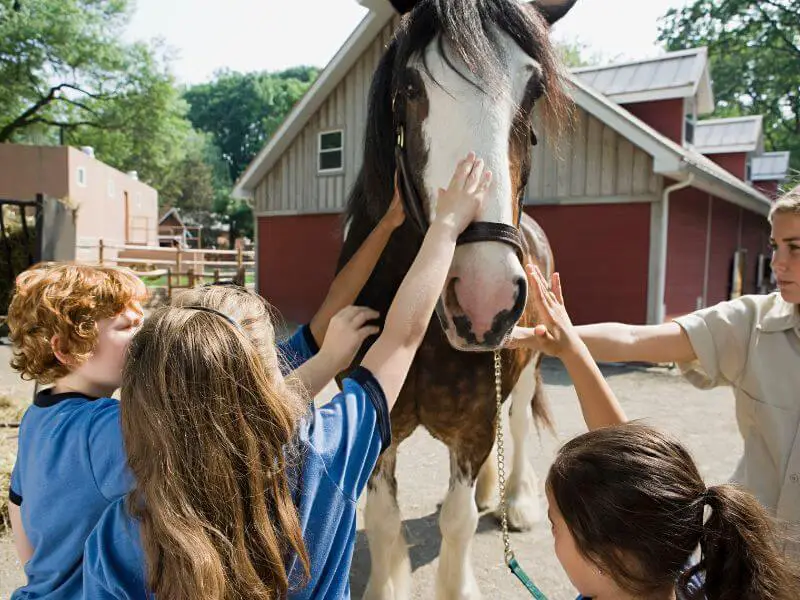
Mistake #4: Not approaching from the side or shoulder
The angle at which you approach a horse can make a big difference in how the horse perceives you. Approaching from the wrong angle can make the horse feel threatened or uncomfortable.
For instance, many people make the mistake of walking up to a horse head-on and quickly reaching up to pet the horse on the face.
This startles the horse, as it’s not only a blind spot but also a sensitive area.
Why the angle of approach matters
Horses have blind spots directly in front of and behind them, which means they can’t see you if you approach from these angles.
This can startle the horse or make it feel trapped or cornered.
The angle of approach affects the horse’s level of comfort and trust, so it’s essential to approach from a safer angle that makes the horse feel more at ease.
The safest angles to approach a horse from
| Angle | Description | Reason |
| Side | Approach the horse from the side, near its shoulder or neck. | This allows the horse to see you clearly, turn its head or front quarters toward you, and reduces the chances of it feeling threatened. |
Tips for adjusting your approach angle based on the horse’s body language
- Approach the horse from the side, near the shoulder, after observing it from a distance.
- Adjust your approach angle if the horse moves or turns away from you.
- If the horse displays signs of discomfort, be prepared to adjust your approach angle.
- Make yourself known by using your voice, and make sure the horse sees you and offers you a sign of recognition.
- Continue to walk slowly and calmly, allowing the horse to sniff your hand.
- Gently stroke the horse’s shoulder or neck.
By paying attention to the horse’s body language and adjusting your approach angle accordingly, you’ll ensure a safer and more comfortable interaction for both you and the horse.
Remember to approach the horse slowly and confidently, speak to the horse, and extend your hand to allow the horse to smell you.
Respecting the horse’s personal space and avoiding sudden movements or loud noises will further improve your chances of building trust and creating a positive experience.
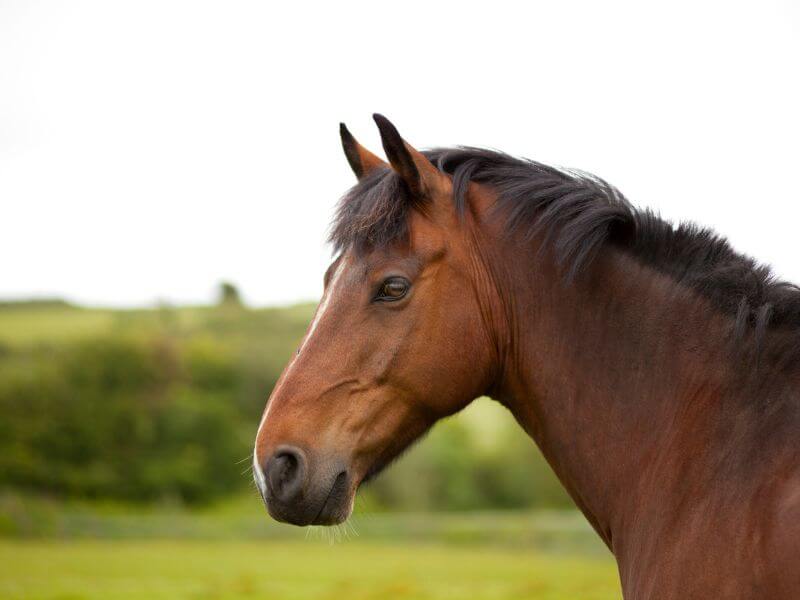
Mistake #5: Approaching with food or treats
Although it may be alluring to use food to court a horse, this tactic might lead to unforeseen issues.
While it’s tempting to try and win a horse’s friendship with a few treats, doing so can backfire in unexpected ways.
Not saying you can’t feed treats to horses there are just risks when you do it the wrong way.
Why approaching a horse with food can be risky
Offering food to a horse can lead to it becoming pushy, aggressive, or disrespectful, expecting treats whenever it sees you.
It can also cause the horse to become overly focused on the food, ignoring your presence and potentially causing accidents.
Additionally, some horses may have dietary restrictions or allergies that you may not be aware of, making offering food a potential health risk.
The risks of using food to lure or bribe a horse
Some risks of using food to approach a horse include:
- Developing bad habits, such as biting or nipping
- Encouraging pushy or aggressive behavior
- Causing accidents due to the horse’s focus on the food
- Losing the horse’s respect and cooperation
- Making the horse associate you with food instead of trust or respect
If you want to train your horse to be caught easily and come when you call them be sure to check my blog post about it.
Tips for building a trusting relationship with a horse without using food
Consider the following suggestions for developing a trusting relationship with a horse without the use of food:
- Without any treats, approach the horse calmly and confidently.
- Spend time combing and patting the horse to establish trust and familiarity.
- Positive reinforcement can be provided through praise and petting.
- Set clear boundaries and guidelines, and be consistent in your horse handling and training.
- Slowly and confidently approach the horse, speak to it, and extend your hand to let the horse to smell you.
- Take note of the horse’s body language and modify your approach accordingly.
By following these guidelines, you can develop a partnership with your horse that is built on trust and respect rather than food or treats.
This will make the experience safer and more pleasurable for both you and the horse.
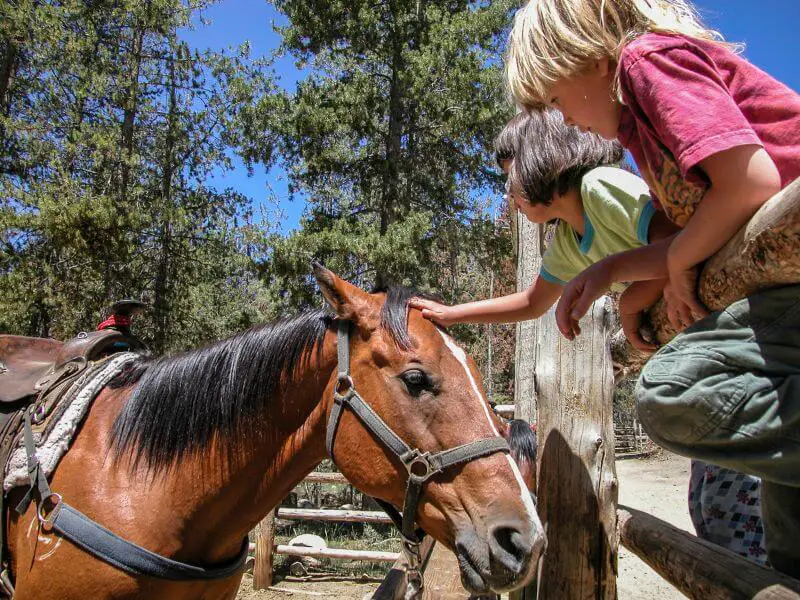
Mistake #6: Not respecting the horse’s personal space
Just like people, horses have personal space boundaries that need to be respected. Invading a horse’s personal space can make it feel threatened and uncomfortable.
The importance of respecting a horse’s personal space
Respecting a horse’s personal space is crucial for ensuring safety and building trust between the horse and the handler. Ignoring these boundaries can lead to anxiety, fear, or aggression in the horse.
How to recognize when you’re invading a horse’s personal space
Look for symptoms of discomfort or unease, such as the horse turning away from you, pinning its ears, or acting in any other way that indicates discomfort or fear.
Back off and give the horse some room if you observe any of these signals.
| Signs of Invading Personal Space | Description |
| Horse moving away | The horse tries to increase the distance between you and itself. |
| Pinned ears | The horse’s ears are flattened against its head, signaling discomfort or aggression. |
| Other signs of discomfort | The horse exhibits wide eyes, raised tail, or other signs of unease. |
Tips for maintaining a safe distance from horses
Keep these suggestions in mind to keep a safe distance from horses and respect their personal space:
- Approach a horse gently and confidently, talk to it and extending your hand so it can smell you.
- To prevent frightening the horse, approach from the side, near the shoulder.
- Allow plenty of room for the horse to move and turn while avoiding unexpected movements or loud noises.
- Consider the horse’s body language and alter your distance accordingly.
- Set clear boundaries and guidelines, and be consistent in your horse handling and training.
By adhering to these standards, you may provide a safe and comfortable atmosphere for the horse, fostering trust and ensuring a great experience for both of you.
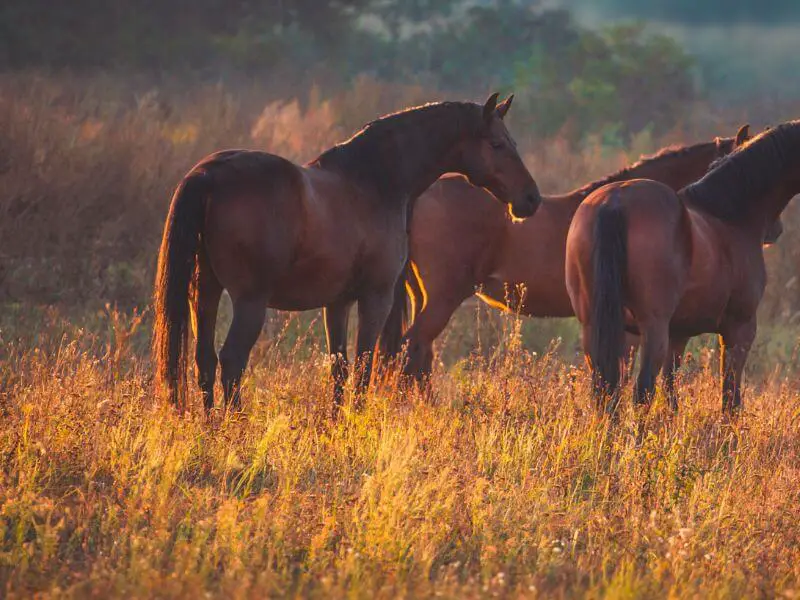
Mistake #7: Approaching a horse from behind
Approaching a horse from behind is one of the most dangerous moves you can make. This must be avoided at all costs. However there is an appropriate way to come up to a horse when they are facing away from you, I will share in a video in this section.
Why approaching a horse from behind is dangerous
Horses have a blind spot directly behind them, and if you approach from this angle, the horse might not see you coming.
This can startle the horse, causing it to react unpredictably with a natural flight response, leading to injury for both the horse and the handler.
They may kick or bolt if they feel threatened.
Tips for approaching a horse safely from the front or side
To approach a horse safely from the front or side, follow these guidelines:
- Move confidently and slowly.
- Walk towards the horse from the front or side, angling towards their shoulder.
- Speak to the horse when approaching to let them know you’re there.
- Extend your hand to allow the horse to smell you and avoid making sudden movements or loud noises.
By following these tips, you can reduce the risk of startling the horse and create a more comfortable environment for interaction.
Risks associated with approaching a horse from behind, including the possibility of being kicked
A horse’s kick can be extremely powerful and cause severe injuries or even death.
When you approach a horse from behind, you’re putting yourself at risk of:
- Bruises, fractures, or broken bones
- Head injuries or concussions
- Internal injuries
Always approach a horse from the side to minimize these risks and pay attention to the horse’s body language, adjusting your approach accordingly. By avoiding approaching a horse from behind, you can create a safer experience for both you and the horse.
Here is the video:
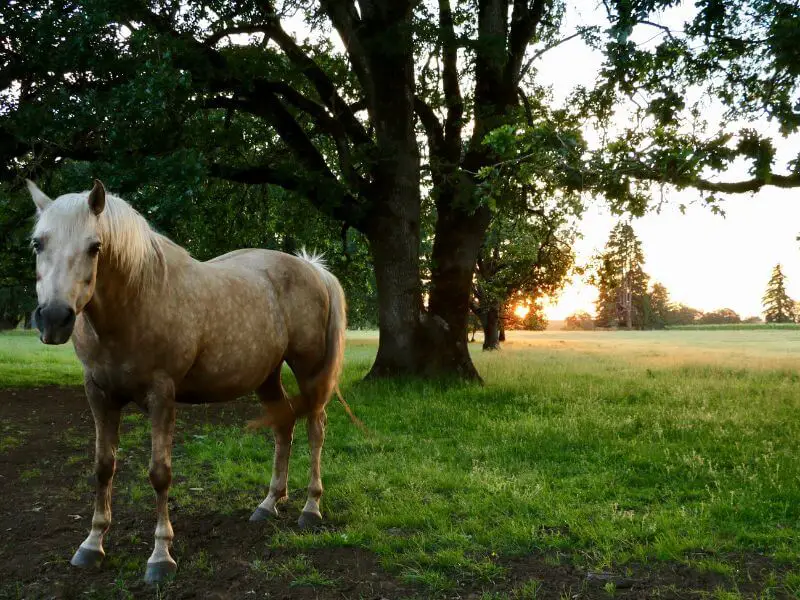
Mistake #8: Not being confident or assertive enough
When you’re around horses, it’s crucial to project confidence and assertiveness.
Horses can sense when you’re unsure or nervous, making them feel uneasy as well.
Why confidence and assertiveness are important when approaching horses
Horses, as herd animals, naturally look for a leader.
Your confidence and assertiveness help establish trust and respect, making the horse more likely to follow your guidance.
Tips for building confidence and assertiveness around horses
- Spend time around horses, observing their behavior and becoming comfortable in their presence.
- Learn about horse behavior and body language.
- Practice handling and training techniques with clear boundaries and consistency.
- Work with a knowledgeable trainer or mentor.
- Employ deep breathing, visualization techniques, and positive self-talk to calm nerves.
- Master groundwork and ride more frequently to develop a stronger bond.
- Walk sideways and angle your shoulders for a less aggressive approach, assessing the horse’s body language and potential triggers.
Risks of not being confident or assertive enough
Lack of confidence and assertiveness may lead to:
- Challenged authority, causing behavior issues.
- Anxious or fearful horses, increasing accident risk.
- Inadequate responses to cues, complicating safe handling.
Incorporating these tips and understanding their importance can help you approach horses with the confidence and assertiveness required for a successful partnership. Remember to be patient with yourself, as building these skills takes time and practice.
| Tips for Confidence & Assertiveness | Risks of Insufficient Confidence |
| Observe horse behavior | Challenged authority |
| Learn body language | Anxious or fearful horses |
| Practice handling techniques | Inadequate responses to cues |
| Work with a trainer | |
| Use calming techniques | |
| Master groundwork | |
| Adjust your approach |

Mistake #9: Not having proper training or experience with horses
Knowledge and expertise are necessary to handle horses safely and successfully.
Without the right instruction, you run the risk of making mistakes that endanger the horse or yourself.
The importance of proper training and experience when handling horses
Proper training and experience allow you to:
- Understand and interpret horse behavior
- Handle horses safely and confidently
- Avoid common mistakes and accidents
Throughout the years, I’ve gained experience and education in horse handling from various sources. I took riding lessons, participated in Pony Club, learned natural horsemanship techniques, and worked as a student at various barns. In college, I even took a class where we trained and showed young horses in hand. All these experiences have shaped my understanding of horses and how to approach them safely.
Tips for gaining experience and education in horse handling
- Take riding lessons or horsemanship classes.
- Attend workshops, clinics, or seminars on horse care and handling.
- Volunteer at a stable, rescue, or therapeutic riding center to gain hands-on experience.
- Seek professional training or lessons from a riding instructor.
- Join a pony or adult horse club or a riding establishment.
- Learn from experienced horse owners or trainers.
- Read books or articles on horse care and training
Risks of not -having proper training or experience, including the possibility of accidents and injury
Lack of training or experience can lead to:
- Misinterpreting horse behavior, resulting in accidents
- Inability to handle horses safely, increasing the risk of injury
- Reinforcing bad habits or behaviors in the horse
- Encountering behavior problems or misunderstandings with your horse that can affect your relationship and performance
- Missing signs of illness or injury in your horse that require veterinary attention
| Tips for Gaining Experience | Risks of Lack of Experience |
| Take riding lessons | Accidents and injury |
| Attend workshops | Reinforcing bad habits |
| Volunteer at stables | Behavior problems |
| Join clubs or establishments | Misunderstandings |
| Learn from experienced handlers | Missing signs of illness |
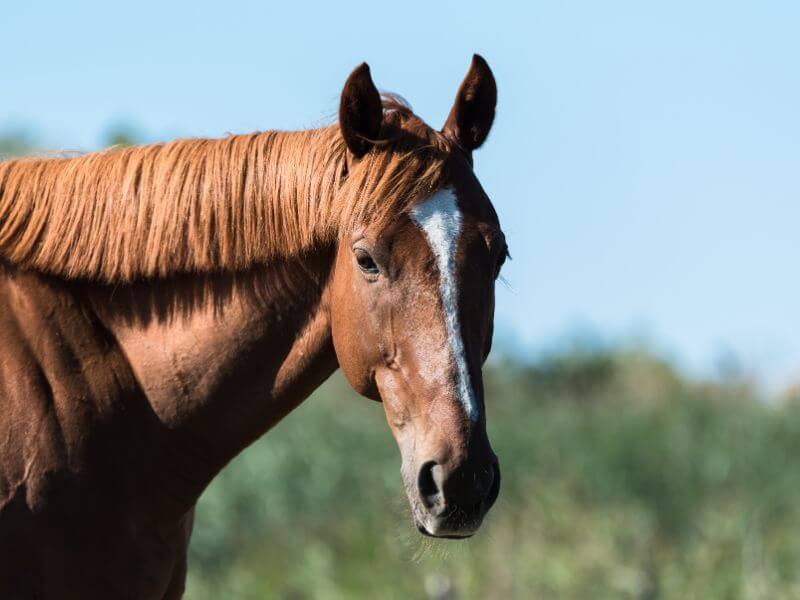
Summing up Mistakes When Approaching Horses
Without the correct training and experience, working with horses may be very confusing.
When interacting with these magnificent animals, safety and trust are of the utmost importance.
Understanding how to approach and engage with horses without putting yourself in danger can be very challenging.
Accidents and injuries can be avoided by following expert advice, observing skilled handlers, and honing one’s own handling techniques.
To recap, here are the mistakes we covered and how to avoid them:
| Key Takeaways: Mistakes to Avoid When Approaching a Horse |
|---|
| 1. Approaching too quickly or suddenly |
| 2. Ignoring the horse’s body language |
| 3. Making loud noises or sudden movements |
| 4. Approaching from behind |
| 5. Not respecting the horse’s personal space |
| 6. Lacking confidence or assertiveness |
| 7. Inadequate training or experience |
| 8. Offering food or treats inappropriately |
| 9. Not approaching from the side or shoulder |
By keeping these points in mind, you’ll be well on your way to becoming an expert in approaching horses.
So go forth, and forge a beautiful bond with these magnificent creatures.
And don’t forget to check out this article for more tips on safely and respectfully approaching horses. Happy trails!
By avoiding these common mistakes, you’ll be able to approach horses in a safer, more respectful way.
Cheer, Kacey
P.S. Did you like this article? Gallop over to:

